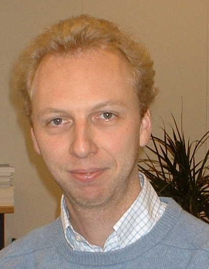Growth and Structure of Complex Oxide Thin Films
Promotion Date: 18th May 2006
| My research was to study the growth of complex oxide thin films by Pulsed Laser Deposition (PLD) using in-situ X-ray diffraction. Pulsed Laser Deposition is a widely used thin film growth technique, especially in the Mesa labs. With PLD it is possible to grow atomic layer by atomic layer, and the differences in structure between different stages of the growth are so small that in order to measure this you need a very powerful X-ray source: a so-called synchrotron. Therefore I spent three years at the ESRF – European Synchrotron Radiation Facility in Grenoble, France, because in The Netherlands such an X-ray source is not available. |
What was your thesis about?
My research was to study the growth of complex oxide thin films by Pulsed Laser Deposition (PLD) using in-situ X-ray diffraction. Pulsed Laser Deposition is a widely used thin film growth technique, especially in the Mesa labs. With PLD it is possible to grow atomic layer by atomic layer, and the differences in structure between different stages of the growth are so small that in order to measure this you need a very powerful X-ray source: a so-called synchrotron. Therefore I spent three years at the ESRF – European Synchrotron Radiation Facility in Grenoble, France, because in The Netherlands such an X-ray source is not available. A synchrotron is a very big ring (ESRF: 800 m circumference) in which electrons (or positrons) circulate at nearly the speed of light, thereby emitting radiation. Since such a machine is very costly, there are 17 countries, amongst which The Netherlands, participating in the ESRF, resulting in an annual budget of nearly 60M€. Yearly, around six thousand scientists from these European countries come to Grenoble to use this radiation in one of the 64 laboratories installed around the ring. In my PhD project formulated in close collaboration with MESA+, I looked at the structure evolution during growth of complex oxide thin films using synchrotron radiation.
Why complex oxide thin films?
Complex oxides have been known for quite some time now for their (technologically) interesting properties, like ferro-electricity, superconductivity or magnetic to name just a few. When grown into thin films the complex oxides often exhibit physical properties that are quite different from the bulk materials. Sometimes worse, but sometimes very exotic and therefore exciting phenomena can be seen. A key to understanding these differences and maybe improving the properties is by looking at the atomic structure, which depends a lot on the fabrication process. By PLD the growth can be controlled very accurately, however not many studies are devoted to the evolution of the atomic structure during the growth.
What are your findings?
We obtained quantitative data from which we are developing structural models concerning the growth. These results will not only be helpful in understanding the physical properties of the thin films but also to better interpret the data obtained in more traditional monitoring techniques, like electron diffraction.
How did you come to do this project?
The idea was initiated during my master's project, which I also did at the ESRF. It seemed a very logical next step for me to pursue a PhD in that project.
Did you like your years in France?
Very much. Grenoble is, certainly in the field of science, a very international city. People from all over the world work at the various institutes you have there. Very stimulating, especially the mountainous area.
What did you like the best of these past four years?
To have noticed to have grown in a number of ways. Scientifically not only in my own subject, but also in general in relation with other subjects. And also in a more personal way: proficiency in languages for instance.
What were you moments of despair?
I did not have many to tell you the truth. I think I owe my supervisors a lot.

